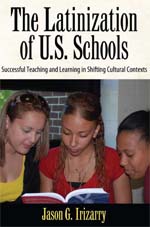The Latinization of U.S. Schools: Successful Teaching and Learning in Shifting Cultural Contexts
by Jason G. Irizarry
From Paradigm Press
Fueled largely by significant increases in the Latino population, the racial, ethnic, and linguistic texture of the United States is changing rapidly. Nowhere is this “Latinization” of America more evident than in schools. Dramatic population growth among Latinos in the United States in recent decades has not been accompanied by similar sizeable gains in the academic achievement of this group. Data regarding the academic achievement of Latino students are alarming. Estimates suggest that approximately half of Latino students fail to complete high school, and too few enroll in and complete college. As educators, researchers, and policymakers search for solutions to address the underachievement of Latino youth in schools, they often ignore the perspectives of those most directly affected by the problem—namely Latino youth themselves.
In contrast, The Latinization of U.S. Schools moves beyond general statistical portraits and centers on the voices of youth to critically examine how a group of Latino students makes meaning of policies and practices within schools, such as tracking and the virtual exclusion of Latinos from the curriculum. These perspectives, although often suppressed within schools, expose an inequitable opportunity structure that results in depressed academic performance for many Latino youth. Perhaps most significant, each chapter concludes with empirically based recommendations for educators seeking to improve their practice with Latino youth stemming from a multiyear participatory action research project conducted by Irizarry and the student contributors to the text.
From Paradigm Press
Jason G. Irizarry is an Assistant Professor of Multicultural Education in the Department of Curriculum and Instruction in the Neag School of Education, and he is Faculty Associate in the Institute for Puerto Rican and Latino Studies at the University of Connecticut.

Comments by emayorga